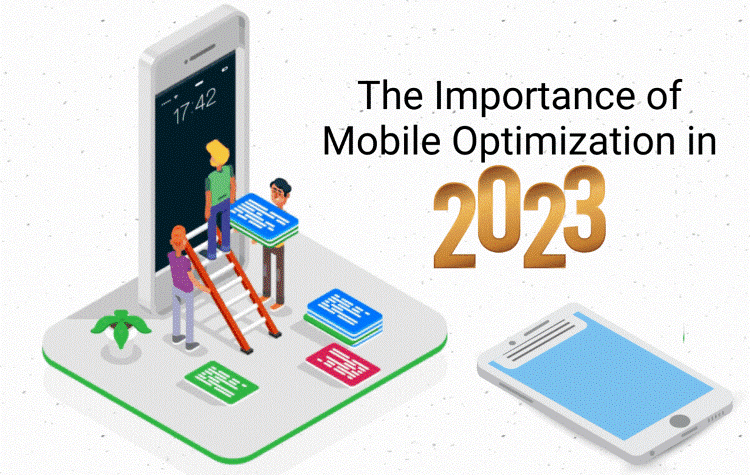Drive Website Traffic and Conversions with Customized Mobile Optimization Solutions
Drive Website Traffic and Conversions with Customized Mobile Optimization Solutions
Blog Article

The Ultimate Guide to Mobile Optimization: Approaches for Enhancing Site Efficiency on Smartphones and Tablets
The strategies for enhancing web site performance on mobile platforms go beyond mere adjustment; they incorporate a thorough approach that involves receptive design, speed optimization, web content techniques, and user experience improvements. By diving right into the complexities of mobile optimization, companies can not only fulfill user expectations but also stay in advance in a competitive electronic landscape.
Value of Mobile Optimization
Mobile optimization plays a critical role in boosting customer experience and driving conversion prices in the ever-evolving digital landscape. With the increasing use smart devices and tablets for surfing the net, ensuring that internet sites are optimized for mobile devices has actually ended up being critical for services - Mobile Optimization. A mobile-optimized web site not just adjusts seamlessly to various screen dimensions however also lots promptly, offering users with a smooth and satisfying browsing experience
In today's fast-paced globe, individuals anticipate instantaneous access to details on the move. A web site that is not enhanced for smart phones risks shedding potential clients as a result of slow down filling times or a poor interface. By purchasing mobile optimization, businesses can accommodate the requirements of their mobile target market, resulting in greater engagement and increased conversions.
Additionally, online search engine like Google focus on mobile-friendly internet sites in their positions, making mobile optimization important for improving visibility and drawing in natural web traffic. Mobile Optimization. In general, the significance of mobile optimization can not be overemphasized, as it directly influences user contentment, conversion rates, and general organization success in the digital realm
Responsive Design Methods
Executing responsive style strategies ensures that sites dynamically readjust their format and material based on the individual's tool screen dimension, offering a consistent individual experience across different systems. Among the most typical techniques utilized in receptive design is creating fluid grids that permit material to resize proportionally to the screen size. This ensures that components on the page keep their family member spacing and plan, enhancing the viewing experience for customers on different tools.
Furthermore, using flexible images that can scale with the size of the viewport helps avoid images from being chopped or distorted on smaller displays. CSS media queries play an essential duty in receptive layout by enabling designers to use certain styles based upon the device characteristics such as screen size, height, and alignment. By leveraging media queries, sites can adapt their format and design to suit smartphones, tablets, and desktop computer screens perfectly.
Integrating responsive design strategies not only boosts individual experience however additionally adds to improved internet search engine rankings, as internet search engine like Google prioritize you could try here mobile-friendly internet sites in their mobile search outcomes. By welcoming receptive style, web sites can satisfy the varied requirements of customers accessing web content on a range of gadgets, eventually driving interaction and conversions.
Rate and Performance Optimization

One key strategy is enhancing photos and multimedia web content to minimize file dimensions without compromising high quality. Compressing photos, leveraging modern image styles like WebP, and careless loading offscreen photos work approaches to quicken lots times (Mobile see Optimization). Furthermore, decreasing HTTP requests, leveraging web browser caching, and lowering server action times are vital action in improving efficiency.
Applying a material shipment network (CDN) can likewise substantially enhance website speed by dispersing content throughout numerous servers worldwide, reducing latency for users accessing the site from various places. Prioritizing vital above-the-fold web content and deferring non-essential scripts can even more boost viewed performance. By concentrating on speed and efficiency optimization, websites can provide a seamless and gratifying individual experience on smart phones.
Mobile-Friendly Web Content Techniques
Mobile-friendly web content strategies entail customizing the presentation of information to suit the smaller screens and on-the-go nature of smartphone and tablet individuals. Furthermore, damaging up material into shorter paragraphs and making use of bullet points can help enhance readability and make it much easier for individuals to consume info swiftly.
Incorporating engaging visuals, such as images and videos maximized for mobile watching, can also improve the overall customer experience. These visuals must be relevant, top quality, and lots rapidly to stop individuals from wearying. In addition, incorporating interactive elements like quizzes, polls, or studies can improve individual engagement and encourage energetic engagement.
User Experience Enhancements
Structure on the structure of mobile-friendly web content approaches, improving customer experience requires enhancing every touchpoint to make sure smooth interaction and contentment for mobile individuals. One vital facet of improving individual experience on mobile phones is making certain quick loading times. Individuals anticipate websites to pack quickly on their mobile phones and tablets, and any type of continue reading this delays can result in stress and raised bounce rates. Carrying out responsive layout is one more crucial element in enhancing user experience. Receptive layout makes sure that sites adjust to various display dimensions and resolutions, providing a consistent and straightforward experience across various tools.
Optimizing kinds for mobile customers by decreasing the number of areas and using auto-fill attributes can likewise boost the general user experience. By focusing on these user experience enhancements, websites can effectively involve and retain mobile site visitors.
Conclusion
To conclude, mobile optimization is vital for improving internet site efficiency on smart devices and tablets. By carrying out responsive style methods, maximizing speed and performance, producing mobile-friendly web content, and improving user experience, organizations can successfully get to and involve with their mobile audience. It is necessary for websites to adjust to the boosting mobile use patterns in order to continue to be competitive in the digital landscape.
Report this page